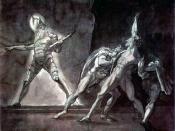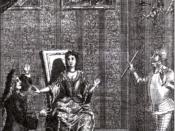William Shakespeare's "Hamlet" has been considered the greatest tragedy to ever be written. While focusing on the third of five acts in "Hamlet", Shakespeare develops the theme of both physical and psychological innocence and corruption through the actions, dialogues, and figurative language of the characters. The evidence of this theme can be seen through the breakdown of the royal family, and the monarchy, by the events surrounding Hamlet's "To be or not to be" soliloquy, The Mousetrap, and the moral decay of the characters through the use of spying and poison.
Hamlet's character is the most puzzling of the whole play. Hamlet's mind erodes further and further as the play unfolds. In act three, Hamlet asks himself whether he should commit suicide or fight the hardships in life, "To be or not to be - that is the question: Whether 'tis nobler in the mind to suffer/ The slings and arrows of outrageous fortune, Or to take arms against a sea of troubles, And by opposing end them.
To die, to sleep--/ No more" (3.1.57-62). Hamlet went from an innocent young man to a mentally decayed person since the murder of his father. Hamlet has been driven to the point of contemplating suicide. According to Hamlet, no good can come from life. The only thing that stops people from killing themselves is the uncertainty of life after death. The format that Shakespeare used when writing Hamlet's soliloquy portrays an insane man speaking with two voices. One wished to commit suicide and the other does not. The back and fourth talk insinuates madness such as schizophrenia. The sudden change from innocence to decay of Hamlet's mind had produced the question of suicide that he had asked of himself.
The Mousetrap is a perfect example of the corruption within the royal family.


